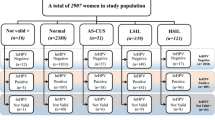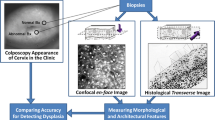Abstract
Classification of cervical intraepithelial neoplasia (CIN) lesions in low-grade (CIN1) or high-grade (CIN2-3) ones is crucial for optimal patient management, but current histological diagnosis on bioptic samples is often hampered by inter-observer variability. To allow objective classification, we have exploited the peculiar characteristics of chemiluminescence detection, such as high sensitivity and easy quantification of the luminescence signal, to perform sequentially in the same tissue section both an immunohistochemical quantitative detection of p16INK4A (a protein marker of high-grade CIN lesions) and an in situ hybridization for human papillomavirus (generally accepted as a necessary but insufficient cause of cervical carcinoma). Different label enzymes (alkaline phosphatase and horseradish peroxidase) were employed in order to avoid any interference between the two assays, and quantitative chemiluminescence image analysis was used to obtain objective evaluation of sample positivity. The multiplexed method allowed detection of two complementary biomarkers and provided discrimination between different lesions (non-neoplastic, low-grade and high-grade CIN). This assay might thus represent an accurate and objective diagnostic test providing important information for counseling, selection of therapy and follow up after surgical treatment.




Similar content being viewed by others
References
Walboomers JM, Jacobs MV, Manos MM, Bosch FX, Kummer JA, Shah KV, Snijders PJ, Peto J, Meijer CJ, Muñoz N (1999) J Pathol 189:12–19
Nobbenhuis MA, Walboomers JM, Helmerhorst TJ, Rozendaal L, Remmink AJ, Risse EK, van der Linden HC, Voorhorst FJ, Kenemans P, Meijer CJ (1999) Lancet 354:20–25
Venturoli S, Ambretti S, Mirasoli M, Santini D, Zerbini M, Roda A, Musiani M (2008) Int J Gynecol Pathol 27:575–581
Keating JT, Cviko A, Riethdorf S, Riethdorf L, Quade BJ, Sun D, Duensing S, Sheets EE, Munger K, Crum CP (2001) Am J Surg Pathol 25:884–891
Murphy N, Ring M, Heffron CC, King B, Killalea AG, Hughes C, Martin CM, McGuinness E, Sheils O, O'Leary JJ (2005) J Clin Pathol 5:525–534
Kalorf AN, Cooper K (2006) Adv Anat Pathol 13:190–194
García-Campaña AM, Baeyens WRG (2001) Chemiluminescence in Analytical Chemistry. Marcel Dekker, New York, NY, USA
Van Dyke K, Van Dyke C, Woodfork K (2002) Luminescence biotechnology: instruments and applications. CRC, Boca Raton, FL, USA
Roda A, Guardigli M, Michelini E, Mirasoli M, Pasini P (2003) Anal Chem 75:463A–470A
Reschiglian P, Zattoni A, Melucci D, Roda B, Guardigli M, Roda A (2003) J Sep Sci 26:1417–1421
Guardigli M, Marangi M, Casanova S, Grigioni WF, Roda E, Roda A (2005) J Histochem Cytochem 53:1451–1457
Bonvicini F, Mirasoli M, Gallinella G, Zerbini M, Musiani M, Roda A (2007) Analyst 132:519–523
Lambert AP, Anschau F, Schmitt VM (2006) Exp Med Pathol 80:192–196
Lorimier P, Lamarcq L, Labat-Moleur F, Guillermet C, Bethier R, Stoebner P (1993) J Histochem Cytochem 41:1591–1597
Lorimier P, Lamarcq L, Negoescu A, Robert C, Labat-Moleur F, Gras-Chappuis F, Durrant I, Brambilla E (1996) J Histochem Cytochem 44:665–671
Musiani M, Zerbini M, Venturoli S, Gentilomi G, Gallinella G, Manaresi E, La Placa M, D'Antuono A, Roda A, Pasini P (1997) J Histochem Cytochem 45:729–735
Marzocchi E, Grilli S, Della Ciana L, Prodi L, Mirasoli M, Roda A (2008) Anal Biochem 377:189–194
Roda A, Musiani M, Pasini P, Baraldini M, Crabtree J (2000) Methods Enzymol 305:577–590
Guo M, Gong Y, Deavers M, Silva EG, Jan YJ, Cogdell DE, Luthra R, Lin E, Lai HC, Zhang W, Sneige N (2008) J Clin Microbiol 46:274–280
Acknowledgements
This work was supported by the University of Bologna (“Strategic University Projects" and "RFO - Focused fundamental research projects”) and the Italian Ministry for Education, University and Research (“PRIN 2007” projects).
Author information
Authors and Affiliations
Corresponding author
Rights and permissions
About this article
Cite this article
Mirasoli, M., Guardigli, M., Simoni, P. et al. Multiplex chemiluminescence microscope imaging of P16INK4A and HPV DNA as biomarker of cervical neoplasia. Anal Bioanal Chem 394, 981–987 (2009). https://doi.org/10.1007/s00216-009-2707-y
Received:
Revised:
Accepted:
Published:
Issue Date:
DOI: https://doi.org/10.1007/s00216-009-2707-y




